An emerging petroleum play with a rapidly growing presence in the unconventional energy sector in South Australia’s Cooper Basin, where a company-making fraccing and flow-testing program is continuing.
| Corporate Details | 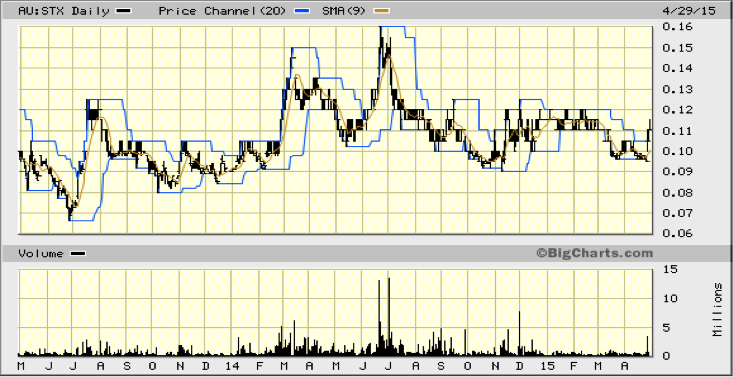 |
| Status: Emerging Producer | |
| Size: Small Cap | |
| Commodity Exposure: Oil & Gas | |
| Share Price: $0.11 | |
| 12-month Range: $0.09 – $0.16 | |
| Shares: 833m, Options: 41m | |
| Top 20: 43% | |
| Net Cash: $8m | |
| Market Value: $92m |
| Key Parameters | Rating (✓out of 5) | Quarterly Statistics |
| Management Quality | ✓✓✓✓✓ | Q4 2014 Exploration & Dev’t Spend: $6.473m |
| Financial Security | ✓✓✓✓✓ | Q4 2014 Administration Spend: $0.915m |
| Project Quality | ✓✓✓✓✓ | Exploration Spend 88%, Admin Spend 12% |
| Exploration / Resource Potential | ✓✓✓✓✓ | Q1 2015 Forecast Exploration Spend: $6.029m |
| Project Risk | ✓✓✓✓✓ | Q1 2015 Forecast Admin Spend: $1.08m |
We introduced Strike Energy to our Portfolio during March 2012 based on a series of very positive initial meetings with Managing Director, David Wrench, where the company’s commercial potential was apparent. Strike Energy has undergone a major rejuvenation over recent years, comprising a revitalization of both its board and its management teams, along with a diversification away from its prior historic focus on USA petroleum activity. The company’s primary focus is now its hugely prospective Cooper Basin gas acreage.
The unconventional energy space within Australia does have enormous potential, but there are clear geographic and commercial considerations. Strike has deliberately targeted projects within specific locations of South Australia’s Cooper Basin, based on important fundamentals: firstly, their proximity to essential energy infrastructure and growing energy markets; and secondly the comparatively low-cost of exploration, appraisal and production activity, based on what are relatively shallow reservoir targets.
In our view, Strike Energy is one of the most prospective ‘unconventional’ energy plays available to Australian investors, something that’s reflected in the methodical manner in which it has firstly identified its acreage, undertaken meaningful exploration activity, signed up cornerstone gas customers – and now appraising the commercial potential of its gas resources. The benefits of such a careful and rigorous evaluation process are steadily becoming apparent for the company’s loyal shareholder base.
Recent Activity
The steady appreciation in Strike’s share price over the past two years is reflective of technical success with respect to its drilling, fraccing and flow-testing programs within its Cooper Basin acreage. Bear in mind too that this performance is further enhanced by the fact that the junior resource sector (and particularly the petroleum sector) has performed poorly in a general sense over recent years.
Strike has adopted a methodical approach to acreage selection, along with exploration and appraisal activity, and it has signed up significant cornerstone gas customers – which provide a strong level of confidence in its commercial prospects. The current flow-testing program is going a long way towards demonstrating commerciality of Strike’s PEL 96 & 94 gas resources.
Initial independent Cooper Basin gas resource estimate
As previously discussed, Strike has now reached a critical stage in the evaluation of the Southern Cooper Basin Gas Project (SCBGP), as having confirmed the presence of a highly productive, self-sourcing hydrocarbon reservoir system across extensive areas of the Southern Cooper Basin; the next key step is to understand the productive potential of the play.
To this end, Strike this week provided an important update on the ongoing production-testing program currently underway at its SCBGP, focused within PEL 96 (Strike 66.7% and Operator, Energy World Corporation (ASX:EWC) 33.3%). Strike advised that leading international petroleum industry consulting firm, DeGolyer and MacNaughton, has independently certified contingent gas resources within PEL 96 for the initial zones that have been flow-tested within the Le Chiffre 1 and Klebb 1 wells.
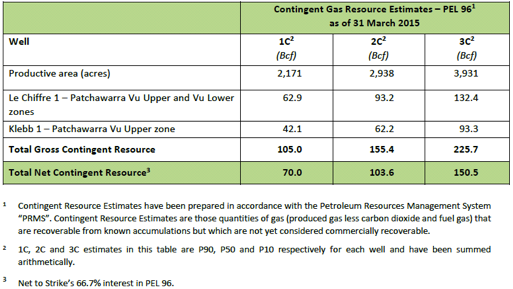
The Contingent Resource has been estimated using probabilistic methods, with reservoir data acquired from all four of the Le Chiffre and Klebb wells incorporated into the original gas in place (OGIP) calculations. Recovery factors derived from numerical simulation were then applied and the resulting volumes have then been adjusted for non-hydrocarbon fractions and an allowance for fuel gas.
For the contingent resources to be classified as reserves, establishment of sustained commercial gas flow rates from the Patchawarra Vu coals will be required in order to better define gas and water production rates and volumes, drainage pattern and well spacing. Additional drilling will also be required to confirm the reservoir quality and gas content of the coals outside of the existing contingent resource areas in order to grow and upgrade the resource to reserves.
DeGolyer and MacNaughton has estimated a threshold economic field size (TEFS) of 150 Bcf of sales gas (gross) which is the minimum amount of gas required to be recovered to underpin a commercial development. The TEFS estimate was based on actual cost data and indicates that the existing 2C sales gas volume of 155 Bcf will be sufficient to underpin a project development.
Technical Significance
Importantly, the project already satisfies a range of other typical contingencies including low well costs, gas sales agreements, proximity to pipeline infrastructure and market pricing. Furthermore, as the current zones only represent a portion of the net coal encountered at these locations, successful flow testing of additional zones will enable an increased contingent resource to be booked.
The review has importantly confirmed Strike’s assessment of the results of the drilling and flow-testing work undertaken so far, in particular the existence of high gas saturation and gas content, along with the productive potential of the coals.
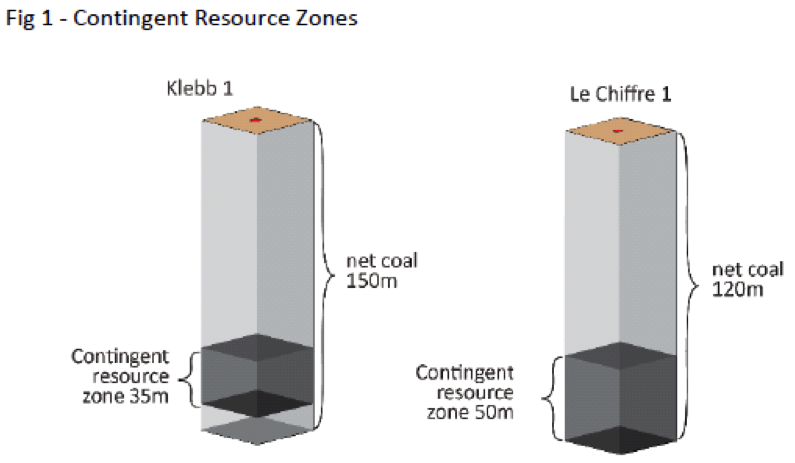
The initial zones have been flow tested that have been assigned contingent resource estimates represent just 30% of the net coal observed within the Le Chiffre 1 and Klebb 1 wells. Successful flow-testing of additional zones in the wells will allow additional contingent resources to be booked at these locations.
Furthermore, Strike has increased the Phase 1 area to 45,500 acres – based on revised mapping of the coals following recalibration of seismic data to drill results. Given that the contingent resource estimates have been assigned to an aggregate of around 6,000 acres within the Le Chiffre 1 and Klebb 1 areas, there is considerable scope to increase the size of the contingent resource with planned infill drilling.
Next Steps
The next phases of the PEL 96 appraisal program are designed specifically to convert contingent resources to reserves and increase the project’s resource base. Strike aims to achieve commercial gas flow rates by upgrading the Klebb pilot wells through fracture stimulation of the Klebb 2 and 3 wells, along with the installation of new pumps.
Attention will then turn to drilling and flow-testing of offset wells at the Le Chiffre location, aimed at confirming the commercial production potential of a demonstration project in the pre-development phase. Strike will also drill additional infill wells in order to confirm the reservoir qualities and gas contents of the coals outside of the existing contingent resource areas, which will likely add to contingent resources and reserves.
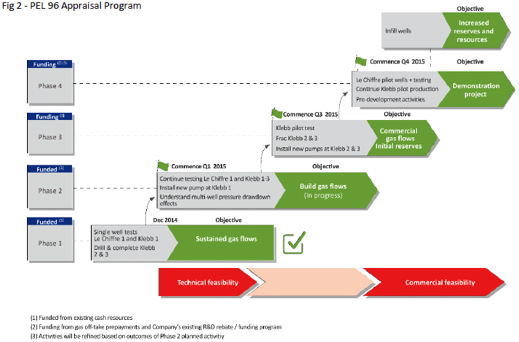
Other Positive Outcomes
The results of the Independent Review entitled Orica (one of the company’s major cornerstone gas customers) to exercise its Option (as approved by shareholders at a General Meeting on 28 May 2014) to subscribe for new shares in Strike for a payment of $2.5 million. The number of new shares to be issued is to be no more 20,833,333 shares and will be determined with reference to a price that is the higher of a 10% discount to the 10 day VWAP prior to the exercise date or $0.12 per share. If Orica does not exercise this option within 30 days, the option will lapse.
The positive outcome of the Independent Review has also triggered the mechanism for the final tranche of Orica’s gas prepayment under their 45PJ Gas Sales Agreement (GSA), whilst also markings the commencement of a 30-day period for Orica to elect to make the first gas prepayment under their 250PJ Gas Sales Agreement. The gas has been contracted at a fixed rate of supply over a 10-year term from 2017, the expected commencement of production from SCBGP.
The GSA complements the foundation contract for up to 250PJ of gas with Orica announced during March 2014 and the Gas Supply Option Agreement with Austral Bricks for 12.5PJ of gas during February 2014. With aggregate contracted off‐take of 307.5PJ (net to Strike) and a balanced portfolio of fixed price, market linked and production cost based tariffs, the SCBGP is positioned for rapid commercialisation.
Cooper Basin Project Background
The Cooper Basin has become Australia’s premier location for evaluation of unconventional resources due to the historical hydrocarbon production, extensive geologic database and existing gas processing, pipeline and service infrastructure. Strike maintains one of the largest exposures to the Cooper-Eromanga Basin, comprising approximately 15,000 sq km across its seven permits.
The Cooper Basin is known as Australia’s most prolific onshore hydrocarbon region. Since the 1970s, the Cooper Basin has supplied more than 5 Tcf of gas to Australia’s eastern and southern gas markets. The Eastern Australia gas markets are experiencing rapidly increasing gas demand due to the development of LNG for export and higher domestic demand. With limited supplies, some domestic customers have commented on an inability to contract the necessary gas volumes to meet their needs beyond 2015.
Three of the Cooper Basin permits (PEL 94, 95 and 96) are on the southern flanks of the Cooper Basin. The southern flank is less thermally mature than the centre of the basin, suggesting that gas may be liquids-prone and may contain significantly less CO2. The projects are ideally positioned to supply the Eastern and Southern Australian gas markets with open-access pipelines passing through the permits.
The current testing program involves the evaluation of a portfolio of five wells, four in PEL 96 (STX 66.6% stake) and one in PEL 94 (STX 35% stake), encompassing a range of completions across the target Patchawarra coal seams. The establishment of gas flows to surface has positioned the SCBGP as one of the few new gas resources, with the potential to supply gas at scale to the Eastern Australian gas markets within the next few years.
The Cooper Basin has become Australia’s premier location for evaluation of unconventional resources due to the historical hydrocarbon production, extensive geologic database and existing gas processing, pipeline and service infrastructure.
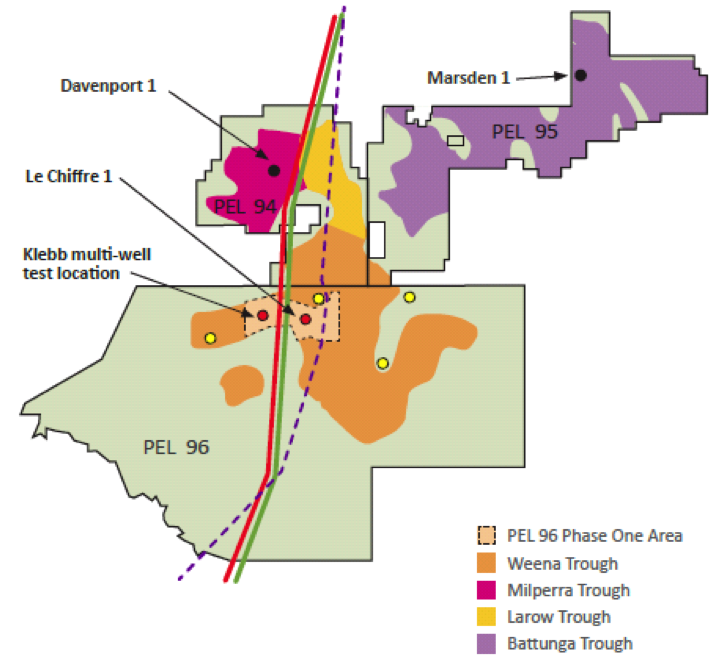
Strike estimates that approximately 75% of the 8.2 to 21.5 Tcf prospective resource within this area is associated with the coal. The project is ideally positioned to supply the Eastern and Southern Australian gas markets with open-access pipelines passing through the permits.
Strike’s prime Cooper Basin permits (PEL 94, 95 and 96) are located on the southern flanks of the Cooper Basin. The southern flank is less thermally mature than the centre of the basin, suggesting that gas may be liquid-prone and may contain significantly less CO2. The unconventional resource within Strike’s permit areas is comparatively shallow, meaning that drilling costs are significantly lower than rival unconventional plays within the central portion of the Cooper Basin.
Improving Gas Market Fundamentals
The gas market in Eastern Australia is transitioning from supply-driven to demand-driven conditions, with commercial and industrial gas consumers increasingly concerned about their ability to secure gas supply contracts beyond the 2015/16 start-up of the three Gladstone LNG export projects. Strike’s Southern Cooper basin gas and liquids resource is ideally located to supply gas directly into this market, taking advantage of existing open-access and under-utilised gas pipeline infrastructure.
Summary
Few companies offer investors such high quality exposure to the huge untapped potential of unconventional energy within the Cooper Basin. Most importantly, the company’s exploration and appraisal costs for the foreseeable future are fully funded and it has keen buyers lined up for future gas production. The positive results from the company’s ongoing flow-testing program have flowed through into a robust initial resource estimate. Accordingly we recommend Strike Energy as a Speculative Buy around current price levels of $0.11 – it is a stock for the patient investor.







